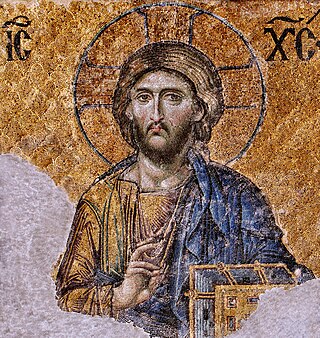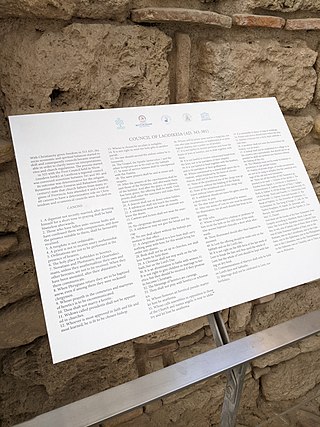
The First Council of Nicaea was a council of Christian bishops convened in the Bithynian city of Nicaea by the Roman Emperor Constantine I in AD 325.

The First Council of the Lateran was the 9th ecumenical council recognized by the Catholic Church. It was convoked by Pope Callixtus II in December 1122, immediately after the Concordat of Worms. The council sought to bring an end to the practice of the conferring of ecclesiastical benefices by people who were laymen, free the election of bishops and abbots from secular influence, clarify the separation of spiritual and temporal affairs, re-establish the principle that spiritual authority resides solely in the Church and abolish the claim of the Holy Roman Emperor to influence papal elections.

Primate is a title or rank bestowed on some important archbishops in certain Christian churches. Depending on the particular tradition, it can denote either jurisdictional authority or (usually) ceremonial precedence.

The Second Council of Nicaea is recognized as the last of the first seven ecumenical councils by the Eastern Orthodox Church and the Catholic Church. In addition, it is also recognized as such by the Old Catholics, the Anglican Communion, and others. Protestant opinions on it are varied.

Pope Cornelius was the bishop of Rome from 6th or 13th March 251 until his martyrdom in June 253. He was pope during and following a period of persecution of the church, while a schism occurred over how repentant church members who had practiced pagan sacrifices to protect themselves could be readmitted to the church. He agreed with Cyprian of Carthage that those who had lapsed could be restored to communion after varying forms of Reinitiation and Penance. This position was in contrast to the Novatianists, who held that those who failed to maintain their confession of faith under persecution would not be received again into communion with the church. This resulted in a short-lived schism in the Church of Rome that spread as each side sought to gather support. Cornelius held a synod that confirmed his election and excommunicated Novatian, but the controversy regarding lapsed members continued for years.
In the medieval Roman Catholic church there were several Councils of Tours, that city being an old seat of Christianity, and considered fairly centrally located in France.

The Council of Laodicea was a regional Christian synod of approximately thirty clerics from Asia Minor which assembled about 363–364 in Laodicea, Phrygia Pacatiana.

The Synod of Elvira was an ecclesiastical synod held at Elvira in the Roman province of Hispania Baetica, now Granada in southern Spain. Its date has not been exactly determined but is believed to be in the first quarter of the fourth century, approximately 305–6. It was one of three councils, together with the Synod of Arles (314) and the Synod of Ancyra, that first approached the character of general councils and prepared the way for the first ecumenical council. It was attended by nineteen bishops and twenty-six presbyters, mostly resident in Baetica. Deacons and laymen were also present. Eighty-one canons are recorded, although it is believed that many were added at later dates. All concern order, discipline and conduct among the Christian community. Canon 36, forbidding the use of images in churches, became a bone of contention between Catholic and Protestant scholars after the Protestant Reformation.
The Councils of Carthage were church synods held during the 3rd, 4th, and 5th centuries in the city of Carthage in Africa. The most important of these are described below.

Brioude is a commune in the Haute-Loire department in the Auvergne-Rhône-Alpes region in south-central France. It lies on the banks of the river Allier, a tributary of the Loire.
The Council of Agde was a regional synod held in September 506 at Agatha or Agde, on the Mediterranean coast east of Narbonne, in the Septimania region of the Visigothic Kingdom, with the permission of the Visigothic King Alaric II.
The First Council of Orléans was convoked by Clovis I, King of the Franks, in 511. Clovis called for this synod four years after his victory over the Visigoths under Alaric II at the Battle of Vouillé in 507. The council was attended by thirty-two bishops, including four metropolitans, from across Gaul, and together they passed thirty-one decrees. The bishops met at Orléans to reform the church and construct a strong relationship between the crown and the Catholic episcopate, the majority of the canons reflecting compromise between these two institutions.
Arles in the south of Roman Gaul hosted several councils or synods referred to as Concilium Arelatense in the history of the early Christian church.
The Council of Clermont of 535 was one of the early Frankish synods. Held at Arvernum,, it was attended by fifteen prelates of the kingdom of Austrasia under the presidency of Honoratus, bishop of Bourges. Among those bishops attending was Saint Gal, the bishop of Clermont.
The Fifth Council of Orléans assembled nine archbishops and forty-one bishops. Sacerdos of Lyon presided over this council. The presence of these bishops indicates both the wide spread of Christianity in Gaul by the sixth century, and the increased influence of the Merovingian kings.
Gaul was an important early center of Latin Christianity in late antiquity and the Merovingian period. By the middle of the 3rd century, there were several churches organized in Roman Gaul, and soon after the cessation of persecution the bishops of the Latin world assembled at Arles, in AD 314. The Church of Gaul passed through three dogmatic crises in the late Roman period, Arianism, Priscillianism and Pelagianism. Under Merovingian rule, a number of "Frankish synods" were held, marking a particularly Germanic development in the Western Church. A model for the following Frankish synods was set by Clovis I, who organized the First Council of Orléans (511).
The Second Council of Orange was held in 529 at Orange, which was then part of the Ostrogothic Kingdom. It affirmed much of the theology of Augustine of Hippo, and made numerous proclamations against what later would come to be known as semi-Pelagian doctrine.
The Council of Paris was a synod convoked by King Chlothar II in 614. It was a concilium mixtum, attended by both ecclesiastics and laymen from throughout the kingdom of the Franks. It was the first of three councils held by Chlothar. It helped secure his rule over the whole kingdom, which he only acquired in 613.






